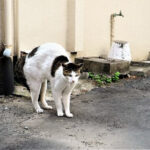While cats generally experience fewer complications during labor compared to dogs, it’s crucial to carefully observe them. Certain issues can arise, particularly in brachycephalic breeds like Persians. If you notice any of the following signs during your Cat Giving Birth, it’s important to contact your veterinarian immediately.
Green Discharge
Observing a green discharge from your cat’s vulva is a serious warning sign. This discharge could indicate that a kitten is in distress, potentially suffering from a reduced blood and oxygen supply. Immediate veterinary intervention is necessary in such cases.
Excessive Bleeding
Some blood is normal during cat labor. However, anything beyond a few drips is considered abnormal. If you notice more than minimal bleeding, it’s essential to seek veterinary attention promptly to ensure the health and safety of both the mother and her kittens.
Signs of Exhaustion
Prolonged labor can lead to exhaustion in your cat. If your cat has been laboring for an extended period and appears to stop straining, this could be a sign of fatigue and potential complications. Veterinary assistance might be required to help her deliver the remaining kittens safely.
Straining Without Kitten Delivery
If your cat is actively straining for 20-30 minutes without producing a kitten, it could indicate a blockage or other obstruction. This situation requires urgent veterinary consultation to determine the cause and provide necessary intervention.
Kitten Stuck in Birth Canal
Large kittens or those with deformities can sometimes become lodged in the birth canal. This can manifest as a kitten being partially visible or not progressing at all. Do not attempt to pull the kitten out yourself. Immediately contact your vet for professional guidance and assistance.
Retained Amniotic Sac
First-time mothers might occasionally need help removing the amniotic sac from their newborns. Allow the mother a moment to handle it herself by placing the kitten near her. However, if she doesn’t remove the sac promptly, you should carefully tear a small opening and remove it yourself. If the sac remains around the kitten’s face for too long, it will prevent breathing. If you are unsure, contact your vet for immediate advice.
Umbilical Cord Issues
Similarly, new mothers might sometimes require assistance with the umbilical cords. While immediate removal isn’t always necessary, if the umbilical cords remain attached for an extended period, they can lead to complications or injuries for the kittens. Consult your veterinarian for guidance on how to properly manage umbilical cords if needed.
Delayed Labor
If your cat shows no signs of labor a few days past her expected due date, it is important to contact your veterinarian. A delayed labor could indicate underlying issues that need to be addressed to ensure a safe delivery.
Stillborn Kittens
If any kittens are born stillborn, it’s crucial to have your cat examined by a vet. Stillbirths can sometimes indicate problems that could affect the mother’s health or future pregnancies.
Maternal Illness
Monitor your cat’s overall well-being closely before, during, and after giving birth. If she appears unwell or acts differently than her usual self at any point, it is important to seek veterinary advice. Postpartum complications can sometimes arise and require prompt treatment.

